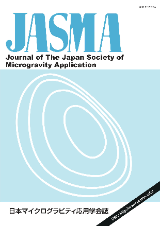巻号一覧

17 巻 (2000)
- 4 号 p. 227-
- 3 号 p. 141-
- 2 号 p. 49-
- 1 号 p. 1-
17 巻, 1 号
毛利サマースクール
選択された号の論文の5件中1~5を表示しています
- |<
- <
- 1
- >
- >|
-
鈴木 増雄2000 年 17 巻 1 号 p. 1-
発行日: 2000/01/31
公開日: 2021/01/21
ジャーナル オープンアクセスPDF形式でダウンロード (347K) -
瀬川 大資, 角田 敏一, 前田 聡, 坂田 直美, 片岡 克己2000 年 17 巻 1 号 p. 2-
発行日: 2000/01/31
公開日: 2021/01/21
ジャーナル オープンアクセスA spherical combustion chamber was provided in the present experiment to measure the burning velocities of homogeneous lean mixtures of air and gaseous fuel under microgravity. A 5 m drop tower realized microgravity for about 1 s by dropping the chamber freely. The burning velocity of the mixtures was determined from the measured time histories of the chamber pressure. Methane was chosen as the test fuel, because it is the major component of natural gas and natural gas is considered to be one of the most promising candidates as alternative fuel for several application. The effects of pressure, temperature and equivalence ratio on the burning velocity were examined. The burning velocity was found to decrease with an increase in pressure and with a decrease in temperature or equivalence ratio. The addition of small amount of hydrogen was effective for increasing the burning velocity.抄録全体を表示PDF形式でダウンロード (2354K) -
石川 正道2000 年 17 巻 1 号 p. 14-
発行日: 2000/01/31
公開日: 2021/01/21
ジャーナル オープンアクセスNonequilibrium systems show spatio-temporal dynamics of self-organization, pattern formation, phase change, etc. Phenomenological aspects of physical principles are explained based on growing fluctuation due to system instabilities. Microscopic fluctuation grows rapidly up to the macroscopic scale which forms visible spatial structures. Such structures are called dissipative structures. Dissipative structures are maintained by the difference of chemical potential, that is, temperature or density difference, etc. In this conditions, convection due to gravity often couples with nonequilibrium dynamics and modifies the physics observed. According to this considerations, physical principles of gravity effects on nonequilibrium systems, such as BZ reactions, nucleation, and phase change are summarized.抄録全体を表示PDF形式でダウンロード (2046K) -
西尾 茂文2000 年 17 巻 1 号 p. 17-
発行日: 2000/01/31
公開日: 2021/01/21
ジャーナル オープンアクセスPool boiling refers to boiling under natural convection conditions. Heat transfer characteristics of pool boiling is usually given by the so-called boiling curve which has the nucleate, transition, and film boiling regions. Nucleate boiling is a very efficient mode of heat transfer, but there exists the maximum heat flux for nucleate boiling. Film boiling is not efficient from the viewpoint of heat transfer because the boiling surface is covered by a vapor film. There exists the minimum heat flux which can sustain film boiling, and the transition boiling curve intervening between the nucleate and film boiling regions has a negative slope. Pool boiling heat transfer is one of complicated heat transfer phenomena because it relates to the following elementary processes; molecular kinetics of phase change, supersaturation of mother phase, interfacial stability, dynamics of contact line, nucleation and growth of new phase, and interfacial morphology. This overview presents the outline of pool boiling heat transfer in relation to such elementary processes.抄録全体を表示PDF形式でダウンロード (1872K) -
日比谷 孟俊2000 年 17 巻 1 号 p. 30-
発行日: 2000/01/31
公開日: 2021/01/21
ジャーナル オープンアクセスPDF形式でダウンロード (737K)
- |<
- <
- 1
- >
- >|